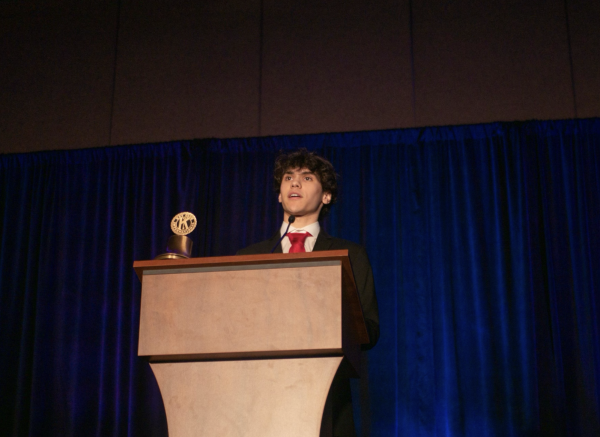The problem with PE dress codes
A student enters the girls’ locker room. Recently, a dress code policy banning tank tops in PE has become controversial in some classes.
What does a rebellion look like? It might be a dystopian protagonist leading an underground retaliation against Orwellian leaders, or an angsty kid sneaking out of a window to go to a party.
But at first glance, a high school girl wearing tank tops to PE might not seem like one. For weeks, Brianna Reynolds* has worn tank tops to her Team Sports class to rebel against the teacher’s anti-tank top dress code.
Reynolds eagerly shared her experiences about getting dress-coded. “Okay, so,” she started, her excitement audible through the speakerphone. She retold the story of being dress-coded two days in a row by the same PE teacher—once in the locker room, the second time in the gym.
Since then, she’s “made a personal commitment to always wear tank tops to PE. My teacher gave me the stink-eye, but she didn’t dress code me again after those two times.”
Why fight this rule in the first place? Reynolds is unable to find anything in the dress code saying she can’t wear a tank top, and the PE dress code is inaccessible online. “I’ve checked the syllabus and everything,” she said. “There is nothing explicitly said in the handbook or the syllabus about exposed shoulders. I couldn’t find it anywhere.”
So, what is the dress code for PE? Both the Beaverton School District Student Handbook and the Code of Conduct list the parameters for student dress. Neither mention tank tops. The only relevant statement about clothing in the BSD Code of Conduct states that “immodest attire” may be disruptive to classrooms.
However, a document, “Physical Education Safety-Quick Guide,” is available only for PE teachers and their substitutes. It lists guidelines on shirts appropriate for high school PE and is only available upon request to a PE teacher. Still, there are no specific mentions of tank tops, only that the only shirts permitted are a “Crewneck or long sleeve t-shirt or sweatshirt.” There is no mention of any other kind of shirt. there are no rules concerning shirts for grades younger than middle school.
If this were such an important factor in physical education, why aren’t the rules about exposed shoulders more widely accessible, or, at the very least, stated clearly in the guidelines? How can one student deduce such a strict “no tank tops” rule without any mention of them? And why aren’t tank tops allowed, anyway?
The answer depends on who you ask. For PE teacher Melissa Merrick, it’s about physical activity.
“Tank tops would allow for wardrobe malfunctions to happen as opposed to a regular t-shirt,” says Merrick. “Specifically, just exposed body parts. If we’re doing yoga and you’re going down into a downward dog position, that would allow for things to maybe come out from under or out the top of a tank top.”
In her class, there’s “a lot of running and jumping and things like that…so any of those types of activities where there’s just a lot of movement could cause a situation like that.”
However, this is specific to her PE classes. When she coaches basketball in the fall, the uniform is a tank top. And basketball isn’t the only sport allowing them. Reynolds, a runner and pole vaulter on the Beaverton High School team, recalled that they don’t seem to have any issue with tank tops either.
“Track doesn’t care,” she said. “You can wear sports bras, and [coach] Boyer doesn’t care.”
So, does it have to do with the fact that girls’ sports teams are, well, just girls?
Luci Clark, a student at Beaverton, hosts a podcast with an episode called “rape culture in school” that addresses this very topic. In it, she and her guests cover why they think the dress code is put into place.
I think we use the word ‘safe’ a lot. Like, ‘safe’ and ‘appropriate.’ What are we ‘safe’ from?
— Luci Clark
“I think we use the word ‘safe’ a lot,” Clark said. “Like, ‘safe’ and ‘appropriate.’ What are we ‘safe’ from? What are we trying to keep women—and men, as they say, though women are being targeted—what are we keeping them safe from?”
While Merrick’s concern that wardrobe malfunctions could cause a disruption in class is valid, what is the likelihood that someone’s ‘body parts’ would fall out of their tank top? It seems to apply much more to students of a certain body type.
“Not everybody is as developed or shaped the same, and so when a girl with a larger chest wears a tank top, they get targeted more than someone with a smaller chest,” Clark said in her podcast.
Despite the students’ strong belief that the dress code targets girls and other feminine presenting students, a teacher might not have that same opinion.
“I don’t think the dress code is stricter towards girls,” said Merrick. “I think from a fashion standpoint, more girls wear tank tops to school than boys…It might seem disproportionate that we have to remind girls more often, but that’s because they wear them to school more often.”
Why do girls wear tank tops more often? It could simply be that they’re easy to exercise in. But while students see tank tops as comfortable workout gear, some PE teachers may see them as obstacles regarding movement.
Many believe this rule creates a double standard aimed at women. Merrick disagreed, claiming that the rule regarding tank tops “does not present an unfair versus fair outlook.”
“I do think it’s fair in the sense that, male or female, that’s the expectation,” she said.
While I’ve seen the ‘tank top rule’ enforced on boys too, it felt forced. Merrick even called out to me as I was leaving the gym, showing me that she did, in fact, dress code a boy for his tank top.
The main problem with the dress code for PE classes? It doesn’t feel like it’s doing anything. And while certain types of tank tops could be hard to exercise in, athletic tanks and even sports bras are made to move in.
Yet another issue? To students, the rule feels pedantic and unfair.
It feels like a way to control [us]… because we’re young, and we listen. It felt like they were prioritizing control.
— Brianna Reynolds
“It made me feel so… indignant,” said Reynolds. “I love my shoulders, and I feel like in a way when they’re telling us not to show shoulders… it’s like a uniform, but it’s just for girls. It feels like a way to control [us]… because we’re young, and we listen. It felt like they were prioritizing control,” she said.
Reynolds’s hopes for change aren’t drastic. “I just want it [the PE dress code] to be more inclusive and to accommodate temperature. The gym can get really warm,” she said. “A t-shirt sometimes just can’t cut it, you know?”
And while Merrick ensures that students can “take breaks as needed” if they’re feeling too hot in their t-shirts, it doesn’t seem like students can exercise at their best when they’re feeling restricted by what they’re wearing.
While changes can’t be made to the school’s rule against tank tops without Beaverton School District committees, it doesn’t have to be enforced so strictly. By trusting students to wear tank tops safely and respectfully, it creates not only a level of trust critical to teaching but also encourages students to take responsibility for what they wear. Chances are, they won’t wear a tank top that they know they can’t exercise properly in.
Feminine-presenting people getting dress coded, both in PE and other classroom settings, seems to be a universal experience. An experience that, in a way, binds this group together against a demeaning regulation that has become normalized.
“It made me so confident for one day… I told everyone and I got so much support,” Reynolds said. “It’s like I had started, like, a very, very minor movement, very specific to myself, you know?”
In a way, a movement—a community—has started around an experience that doesn’t make people feel valued, both as students and as individuals. The volume of people experiencing this prevents others from feeling alone. That, in a sense, is its own rebellion.
*This source’s name has been changed to preserve their privacy.

Hannah is a senior at Beaverton. She edits articles and is a co-host on the work-in-progress Hummer podcast, The Beaver Buzz. In her spare time, she enjoys...

Anouk is a senior who writes and edits articles, takes the occasional photo, and helps everything run in the background.











